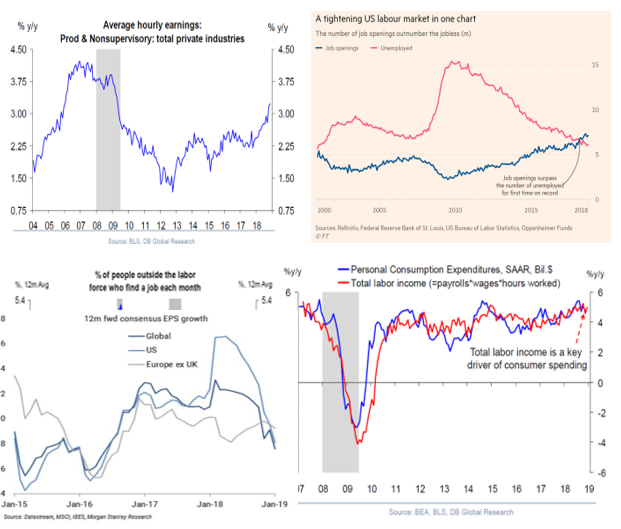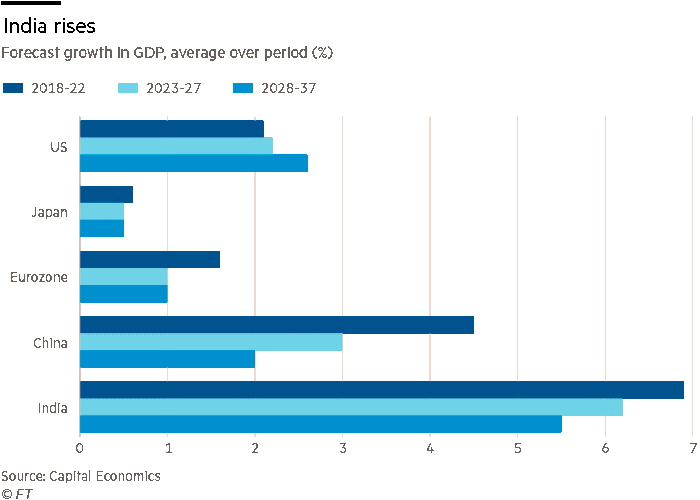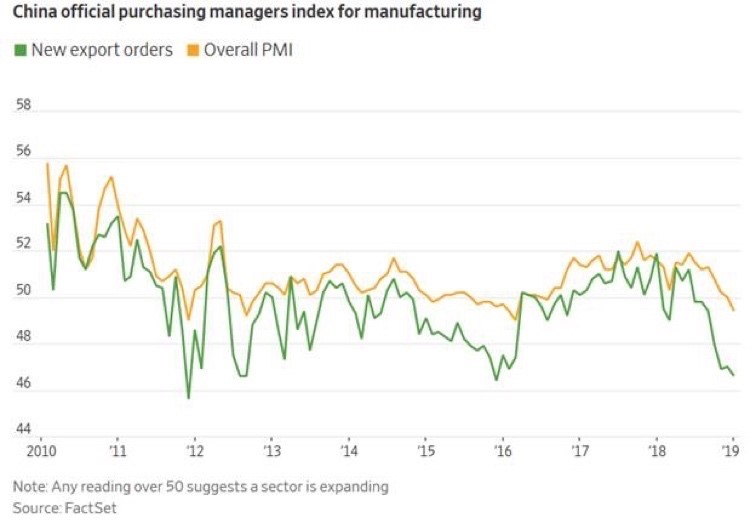
Many refer to the Fed Model to assess relative attractiveness. This model considers the amount of earnings generated by the market, divided by the price to obtain those earnings, and then compares it to the current interest rate of the 10-year Treasury bond. With the U.S. equity market having an earnings yield of 7 percent, and the Treasury at less than 3 percent, the equity market appears to offer the better opportunity. Yet, as we have said, valuation is not a good enough reason on its own to enter or exit the market.
Why? Because earnings expectations will fluctuate. And, at the time of this writing, expectations have been falling in the U.S. Although some will consider what follows a doom and gloom attitude, it is important to realize that the growth in earnings in 2018 was high given the new tax laws. And because that earnings bump will not repeat itself in 2019, it’s understandable to expect the growth rate to decelerate—decelerate, not decline. We still expect to see growth, just not at 2018’s pace.

Much of this report has focused on the U.S. It is the element in our puzzle that brings the most clarity to the global mosaic. Rarely does any other region impact the world markets as much as the U.S. Other markets might dent the growth profile, but rarely do they cause enduring damage to the earnings of the investable universe.
If Europe were a section of a puzzle, it would be the busy but incidental component. Europe has seen a lot of headlines, and no doubt has internal issues to resolve, but the range of possible outcomes to various European quandaries should not have much impact on the average investor. Brexit and Italy have been favored topics, and a recent slowdown in Germany is adding additional concern to the continent’s growth in 2019.
Capital Economics—a well-respected macroeconomic research firm—specializes in long-term growth forecasts, and they predict little change in growth for Europe in the future. Demographics, and the burden of the state, limit swings in growth rate. At Auour, we continue to be underweighted in the developed international markets, especially Europe, because few positive catalysts exist. However, valuations have come down such that any change in our outlook will likely be towards increased exposure.

With Emperor Xi’s assent to the leadership role, China has made significant moves back towards the Communist Party and authoritarianism. The party has been on an aggressive debt issuance cycle, and many distinguished researchers see that as the leadership’s attempt to maintain control.
Much of the growth in debt has been within the state-owned corporate space and was funded through the internal savings of the population. We have written about the rapid growth in WMP’s and the expected guarantee of their savings by the central government. In 2018, China saw a material increase in defaults and the removal of ancillary parts of the lending machine (peer-to-peer lending being one example). Consumer spending decelerated significantly in 2018, as seen with many of the luxury consumer goods producers. (Apple is one example, but it is far from the only one.) It remains unclear if there is a connection, but our guess: there is.

Because of the internal funding of China’s debt, similar to Japan’s and Italy’s, we do not see any bursting of that bubble to be a large-scale shock to the world. Instead, we see it as a slow bleed that will take decades to correct. We go back to the Japanese example for context: It was the second-largest economy, but, over the last 30 years, has become the fifth largest. It is still very wealthy, but demographics and the slow rebuild of their banking system have together placed them in a position of relative weakness. Today, China faces tough demographics, an inflated banking system, a shift back towards authoritarianism, and a lack of new growth opportunities. Its outlook is not attractive to us.
Conclusion

Market sentiment experienced significant change in 2018. From expecting synchronized global world growth to fearing economic ruin, the shift to the negative became pervasive. The puzzle pieces, as assembled so far, however, look like something less dire. Concerns around the world are valid, but the most important engine, the U.S. financial system, appears solid, and the signals are more positive than negative. World events and jockeying amongst world leaders can always produce unpredictable troubles, but we need to remember the world has lived through much more dangerous times. Ask your grandparents.
Our models acted as expected, turning cautious in the early part of 2018 prior to the market turmoil that hit hard in the fourth quarter. Though investors are anxious, our models are starting to show light at the end of this tunnel. We have confidence in the stability shown by the Auour Regime Model, and we wait patiently for the catalysts that will cause us to adjust our positioning.
This article was written by the team at Auour Investments, a participant in the ETF Strategist Channel.

